Aniridia Europe is pleased to publish the lay summary of the session on WAGR spectrum held at the 6th European Aniridia Conference, on 3, 4 & 5 June 2022, in San Juan de Alicante, Spain.
The summary was prepared by Kelly Trout, chaiperson of the International Wagr Syndrome Association (IWSA) and one of the speakers at the Conference.
This session represented the first time the European Aniridia Conference has featured an entire session on WAGR Spectrum. This new focus was a welcome opportunity to highlight recent research on this disorder, and to encourage collaborative research to study the non-ocular conditions associated with congenital aniridia.
The first presentation in this session “Overcoming Barriers and Accelerating Research: Lessons from the WAGR syndrome Patient Registry” was given by Kelly Trout, BSN, RN, Director of Research and Medical Advocacy for the International WAGR Syndrome Association.
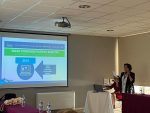
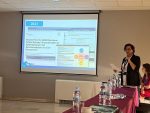 Ms. Trout spoke about how patient registries are used to drive research forward, improving diagnosis by documenting the types and frequency of conditions associated with a given disorder, and by providing the data to make new treatments possible. She described the WAGR Syndrome Patient Registry as an online questionnaire that patients or parents fill out, answering questions about their medical history. These answers become the data that scientists study, data that leads to discoveries and breakthroughs.
Ms. Trout spoke about how patient registries are used to drive research forward, improving diagnosis by documenting the types and frequency of conditions associated with a given disorder, and by providing the data to make new treatments possible. She described the WAGR Syndrome Patient Registry as an online questionnaire that patients or parents fill out, answering questions about their medical history. These answers become the data that scientists study, data that leads to discoveries and breakthroughs.
Ms. Trout described the advances that have already been made possible by the WAGR Registry, including important new information about the conditions associated with this disorder. For example, the data in the WAGR Registry has demonstrated that WAGR is more than just Wilm’s tumor and Aniridia, Genitourinary abnormalities and a Range of Developmental Delays. This disorder includes a risk for a variety of serious conditions, including chronic kidney failure, heart problems, and disorders of metabolism, as well as gastrointestinal problems such as chronic and severe constipation. All of these conditions can have a serious impact on a patient’s quality of life. The data in the WAGR Registry not only shows how many patients are affected by these conditions, but it has also made new guidelines for medical care possible. These new guidelines will help patients to be diagnosed early and treated appropriately, saving a lot of suffering and even saving lives.
Ms. Trout also spoke about hope for a global Aniridia Patient Registry. There is great interest in the international community for the development of such a registry, but there are a lot of challenges that will need to be overcome. Fortunately, challenging is not the same as impossible. If an effective and productive Registry can be created for WAGR Spectrum, then a global Aniridia Registry is surely possible.
The second presentation was given by Jennifer Kalish, MD, a geneticist at Children’s Hospital of Philadelphia (USA): “Defining the WAGR Spectrum: Updates from the WAGR Syndrome Patient Registry.” Dr Kalish gave a demonstration of the power of a Registry. She spoke about how her team studied the data in the WAGR Registry, and then produced the clearest and most detailed picture yet of WAGR and all the conditions associated with it.
In addition to producing new guidelines for care, the Kalish study even changed the name of the disorder. Instead of WAGR “syndrome,” the term “WAGR Spectrum” will be used. Spectrum is a better way to describe the broad range of conditions that are possible in patients with WAGR, as well as the wide range in severity of those conditions. The term, “WAGR Spectrum” will help both families and doctors to understand that every individual with this disorder shares some conditions in common, but each is also unique.
Finally, this study also produced a whole new set of guidelines for medical care. Now WAGR families have evidence-based recommendations they can take to their doctors. These recommendations are available at the website, http://www.WAGR.org
Full text can be found here: https://www.frontiersin.org/articles/10.3389/fped.2021.733018/ful
“Consequences of PAX6 mutations in the brain and/or endocrine system” was presented by Jim Lauderdale, PhD, of the University of Georgia (USA) Dr Lauderdale spoke about how PAX6 affects parts of the body besides the eye. For example, people with aniridia often experience difficulty processing language. This is called auditory processing disorder, and it can have a big impact on a person’s life. Children may struggle in school because they have trouble filtering out noises in the classroom. Adults may struggle because their brains have to work a lot harder to process what others are saying. These issues may be the result of differences in the structure of the brain, especially in areas where the two halves of the brain connect. Other problems in the brain may include a missing or smaller than normal pineal gland, which can cause problems with sleep, and a missing or smaller than normal olfactory bulb, which can cause the loss of the ability to smell.
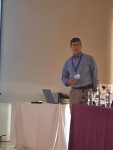
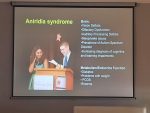
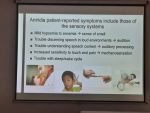 Also, people with aniridia caused by PAX6 mutations can have issues with their metabolism and with controlling their blood sugar, problems with the gastrointestinal tract, and possibly problems with the function of the thyroid gland. Dr Lauderdale emphasized the importance of further study on the effects of PAX6 gene mutations on systems of the body other than the eye, to discover not only what these problems are – but also how best to treat them.
Also, people with aniridia caused by PAX6 mutations can have issues with their metabolism and with controlling their blood sugar, problems with the gastrointestinal tract, and possibly problems with the function of the thyroid gland. Dr Lauderdale emphasized the importance of further study on the effects of PAX6 gene mutations on systems of the body other than the eye, to discover not only what these problems are – but also how best to treat them.
The final presentation in this session, “Nephroblastoma in patients with WAGR syndrome and clinical consequences” was given by Prof. Dr. Norbert Graf, of Saarland University, (Germany). Dr Graf explained that genetic testing is critically important in children with aniridia. If the child is found to have a deletion in the WT1 gene, there must be ultrasound screening for Wilms tumor. If no deletion of the WT1 gene is found, ultrasound screening is not necessary. Regular screening for Wilms tumor is critical because it allows for early diagnosis, when the tumor is smaller in size and the outcome is more likely to be better. Dr Graf explained that in children with WAGR, the age at diagnosis of WT is earlier than in typical kids, and tumor size is smaller, and if you compare screening vs no screening, there’s a big difference in the size of the tumor. Most Wilms tumors in children with WAGR develop before the age of 7-8 years, but monitoring, particularly if the child does develop Wilms, should be lifelong. One of the reasons for lifelong screening is the fact that kids with WAGR have special types of Wilms tumor. Half of these children have nephrogenic rests, which are benign lesions in the kidney that can become Wilms tumor. Some kids with WAGR have many of these lesions, which can be difficult to treat and requires closer/more frequent follow-up. Tumor size also plays an important role in outcome. So it’s a good idea to treat with chemotherapy first to decrease the size of the tumor and to make the tumor easier to remove and allow more of the normal kidney tissue to be saved. Dr Graf also explained that 30% of children with WAGR/Wilms tumor have bilateral tumors (one or more tumors in both kidneys), which can make surgical treatment more complex.
The good news is that most children with WAGR who develop Wilms tumor will survive. But it’s critical to have long-term, close follow up after treatment because of the risk of late relapse, and because of the danger of other WAGR related conditions occurring, like chronic kidney disease.
Finally, Dr Graf stressed that because of the spectrum of WAGR, these children need a team of specialists who are willing to work together, and because of the rarity of this disorder, global efforts to share information and data are vital to making progress on diagnosis and treatment.
